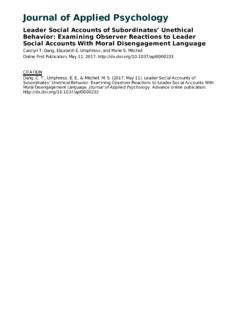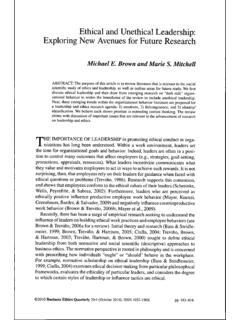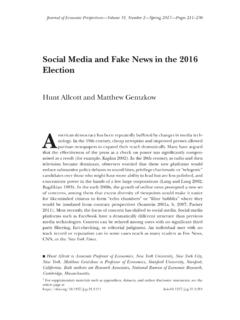Transcription of Crises and Crisis Management: Integration, Interpretation ...
1 Journal of ManagementVol. 43 No. 6, July 2017 1661 1692 DOI: The Author(s) 2016 Reprints and 1661 Crises and Crisis management : Integration, Interpretation , and research DevelopmentJonathan BundyArizona State UniversityMichael D. PfarrerCole E. ShortUniversity of GeorgiaW. Timothy CoombsTexas A&M UniversityOrganizational research has long been interested in Crises and Crisis management . Whether focused on Crisis antecedents, outcomes, or managing a Crisis , research has revealed a number of important findings. However, research in this space remains fragmented, making it difficult for scholars to understand the literature s core conclusions, recognize unsolved problems, and navigate paths forward. To address these issues, we propose an integrative framework of Crises and Crisis management that draws from research in strategy, organizational theory, and orga-nizational behavior as well as from research in public relations and corporate communication.
2 We identify two primary perspectives in the literature, one focused on the internal dynamics of a Crisis and one focused on managing external stakeholders. We review core concepts from each perspective and highlight the commonalities that exist between them. Finally, we use our inte-grative framework to propose future research directions for scholars interested in Crises and Crisis : Crisis ; Crises ; Crisis management ; organizational wrongdoing; perception and impression managementAcknowledgments: We would like to thank Miles Zachary for comments on an earlier draft of the manuscript. We are also grateful to associate editor Karen Schnatterly and two anonymous reviewers for their invaluable feedback and material for this article is available with the manuscript on the JOM author: Jonathan Bundy, Arizona State University, Box 874006, Tempe, AZ 85287-4006, : of ManagementBundy et al.
3 / Review of Crises and Crisis Managementresearch-article20161662 Journal of management / July 2017An organizational Crisis an event perceived by managers and stakeholders as highly salient, unexpected, and potentially disruptive can threaten an organization s goals and have profound implications for its relationships with stakeholders. For example, BP s Gulf oil spill harmed its financial performance and reputation, and it redefined its relationship with customers, employees, local communities, and governments. Similarly, Target s con-sumer data breach caused financial and reputational damage to the company, and the Crisis spurred large-scale changes in the way electronic records are now processed and stored. Because of these implications, organizational research from a variety of disciplines has devoted considerable attention to Crises and Crisis management , working to understand how and why Crises occur (Coombs & Holladay, 2002; Perrow, 1984; Weick, 1993), and how organizations can manage them to reduce harm (Bundy & Pfarrer, 2015; Coombs, 2007; Kahn, Barton, & Fellows, 2013).
4 Organizational research has also considered a number of important Crisis outcomes, including stakeholders perceptions of organizational reputation, trust, and legitimacy (Coombs, 2007; Elsbach, 1994; Gillespie & Dietz, 2009; Pfarrer, DeCelles, Smith, & Taylor, 2008), organizational learning and adaptation (Lampel, Shamsie, & Shapira, 2009; Veil, 2011), and financial performance and survival (D Aveni & MacMillan, 1990; Marcus & Goodman, 1991).However, despite sustained interest across multiple disciplines, recent commentary on the field suggests that we have only just begun to scratch the surface in our understanding of Crises and Crisis management , and encourages further consideration of the theoretical mecha-nisms at work (Coombs, 2010: 479; Pearson, Roux-Dufort, & Clair, 2007). Additionally, research in this area has been criticized for its lack of theoretical and empirical rigor, given that many of its conclusions and prescriptions are derived from case studies or anecdotal evidence (Coombs, 2007; Sellnow & Seeger, 2013).
5 Finally, many scholars continue to lament a silo effect, noting that researchers from different perspectives often talk past one another without capitalizing on opportunities to build cross-disciplinary scholarship (James, Wooten, & Dushek, 2011; Jaques, 2009; Kahn et al., 2013). As such, there is little consensus and integration across fields of study, numerous and sometimes conflicting prescriptions abound, and debates continue regarding the relevant antecedents, processes, and outcomes associated with Crises and Crisis purpose of this article is twofold: First, we review and integrate the literature on Crises and Crisis management from multiple disciplines, including strategic management , organiza-tion theory, and organizational behavior as well as public relations and corporate communi-cation. Second, we contribute to scholarship by specifying a framework that incorporates two dominant perspectives found in the literature.
6 The first perspective is internally oriented toward the technical and structural aspects of a Crisis , while the second perspective is exter-nally oriented toward managing stakeholder relationships. Our review reveals that these per-spectives have developed largely independently, and we identify numerous opportunities for integration. Ultimately, our framework serves as a foundation for future cross-disciplinary research as well an effective tool for and Review FrameworkTo conduct our review, we performed an extensive and integrative search of articles pub-lished in major organizational academic journals, with certain boundary conditions to make Bundy et al. / Review of Crises and Crisis management 1663the review pertinent to management and organizational scholars. Pearson and Clair s (1998) Academy of management Review article has been a foundation of subsequent developments in the literature; therefore, we used their article as our starting point.
7 We cover the time period from 1998 to 2015 with a few exceptions, primarily to reference seminal the recommendations of Short (2009), we primarily focused our review on the following journals: Academy of management Journal, Academy of management Review, Administrative Science Quarterly, Journal of management , Journal of management Studies, Organization Science, and Strategic management Journal. To identify relevant articles from these outlets, we conducted full-text searches on the terms Crisis , Crises , and Crisis manage-ment. We then identified and categorized critical themes to generate a set of articles for inclu-sion. This involved removing articles that did not primarily focus on Crises or Crisis management in their research questions, hypotheses, or propositions. We also extended our methodology by searching the references of the articles identified in our initial search as well as searching for research that cites these articles (cf.)
8 Johnson, Schnatterly, & Hill, 2013; Short, 2009). This led us to include a number of influential books, relevant articles in other respected journals, and research from public relations and communication. Overall, we sought to collect the work that is most relevant to management and organizational a diversity of perspectives and intellectual traditions, our analysis of the multiple definitions of Crises and Crisis management over the past 20 years reveals convergence (see Heath, 2012; James et al., 2011; Jaques, 2009; Pearson & Clair, 1998; and Sellnow & Seeger, 2013, for detailed definitional reviews). Drawing from this convergence, we define an orga-nizational Crisis as an event perceived by managers and stakeholders to be highly salient, unexpected, and potentially disruptive. We also recognize that Crises have four primary char-acteristics: (a) Crises are sources of uncertainty, disruption, and change (cf.
9 Bundy & Pfarrer, 2015; James et al., 2011; Kahn et al., 2013); (b) Crises are harmful or threatening for organi-zations and their stakeholders, many of whom may have conflicting needs and demands (cf. Fediuk, Coombs, & Botero, 2012; James et al., 2011; Kahn et al., 2013); (c) Crises are behav-ioral phenomena, meaning that the literature has recognized that Crises are socially con-structed by the actors involved rather than a function of the depersonalized factors of an objective environment (cf. Coombs, 2010: 478; Gephart, 2007; Lampel et al., 2009); and (d) Crises are parts of larger processes, rather than discrete events (cf. Jaques, 2009; Pearson & Clair, 1998; Roux-Dufort, 2007). Additionally, we recognize that Crisis management broadly captures organizational leaders actions and communication that attempt to reduce the likeli-hood of a Crisis , work to minimize harm from a Crisis , and endeavor to reestablish order fol-lowing a Crisis (Bundy & Pfarrer, 2015; Kahn et al.
10 , 2013; Pearson & Clair, 1998).Definitional convergence aside, a number of scholars prior to and throughout our review period have noted a lack of integration across disciplines and perspectives (cf. Jaques, 2009). For example, Shrivastava (1993: 33) highlighted a Tower of Babel effect, arguing that there are many disciplinary voices, talking in so many different languages to different issues and audiences that it becomes difficult to build cross-disciplinary theory and policy guide-lines. More recently, Pearson and colleagues (2007: viii) worried that the virtual galaxy of critical concepts resulting from this lack of coordination not only may impede on the ability to build theory and aid practice but also risks the legitimacy and credibility of the field as a whole. James and colleagues (2011: 457) echoed this concern in their review of Crisis lead-ership, noting that fragmentation has prevented a widely accepted understanding of, or com-mitment to, a common research paradigm in the field of Crisis management .










